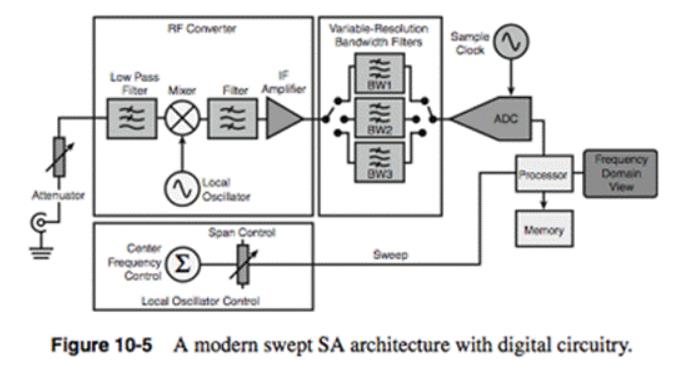1 Wireless signal chain
Wireless signals are an essential part of many embedded systems today. Manufacturers of mobile terminals are discussing media convergence. Consumers can browse the web or watch the game on laptops, mobile phones, portable digital TVs or PDAs.
Simply put, all kinds of media content are "translated" into wireless signals. However, media convergence is actually the forerunner of countless complex technologies, such as enhanced data compression (codec), interoperability, radio frequency transmission, and interference processing. Countless other wireless technologies, such as a large number of international standards and media formats, deserve a special book. But in this chapter, for signal integrity design, we don't need to consider media, standards, and the characteristics of various wireless transmissions, and only focus on testing and analyzing wireless signals. The analysis of wireless signals and spectrum is a method widely used in various professional fields, and it should appear in wireless textbooks.
Moreover, because wireless systems are becoming more and more popular in embedded system design, new wireless standards are also being adopted, and signal integrity engineering should be taken seriously in these wireless environments. Therefore, this book will be incomplete if it does not discuss modern wireless signals and their testing. Therefore, this chapter aims to help you understand the new technology of wireless signal testing. This chapter also provides some new ideas for signal analysis in modern wireless environments.
Discussing signal integrity and measurement is a big project, and it has been controversial to include discussions of wireless test instruments in the extensive SI books. However, this topic is also straightforward, because the spectrum analyzer (SA) is an indispensable tool for radio frequency (RF) testing, and spectrum analysis occupies a dominant position in the design of a wide range of wireless systems and devices. In addition, spectrum analysis is currently used in research and development in fields ranging from low-power radio frequency identification (RFID) systems to high-power radar and RF transmitter systems.
2 RF signal
An RF carrier signal is like a blank piece of paper on which you can write down and spread information. The RF carrier can transmit information by changing the amplitude and phase, which is called modulation. For example, we generally discuss amplitude modulation (AM) and frequency modulation (FM), but in writing, frequency modulation FM is a form of phase modulation (PM). The combination of AM and PM forms the current numerous modulation methods, such as Quadrature Phase Shift Keying (QPSK), which is a digital modulation method, with a 90-degree phase difference between the symbol bits. Quadrature amplitude modulation (QAM) is a widely used modulation method, in which the phase and amplitude will change simultaneously to provide multiple states. Other more complex modulation methods such as Orthogonal Frequency Division Multiplexing (OFDM) can also decompose amplitude and phase components. The basic information provided by the wireless system provides a comprehensive example of how to modulate a carrier signal. In order to understand modulation, an example picture may be more effective than a thousand words.
However, to understand the digital modulation of the wireless carrier, one must be familiar with using vectors to represent the amplitude and phase of the signal. As shown in Figure 10-1, a signal vector can be understood as the instantaneous amplitude and phase of the signal by the vector Length and angle are expressed.
If it is in a polar coordinate reference system, it can also be expressed in a traditional Cartesian coordinate reference system or rectangular coordinates X and Y. In the digital representation of an RF signal, an I signal and a Q signal orthogonal to it are usually used. Mathematically, they are actually equivalent to the X and Y components of the Cartesian coordinate system. Figure 10-2 illustrates the magnitude and phase of the vector, and the state of the I and Q components at that time.
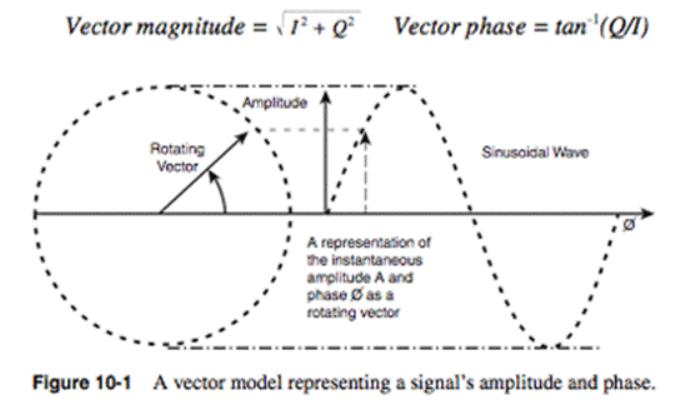
Figure 10-1
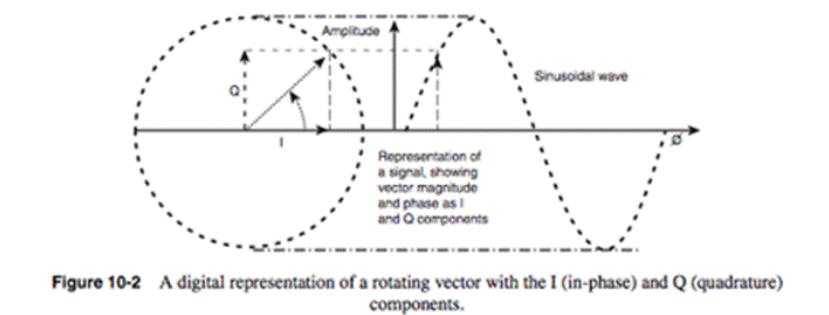
Figure 10-2
For example, an AM modulated signal can be represented by I and Q components. This requires calculating the instantaneous I and Q amplitudes of the carrier. Each instantaneous value is expressed as a number and recorded in the memory. The last stored data (amplitude value) is The expression of the original modulated signal is given. However, PM modulation is not that simple. It also includes phase information. After calculating the I and Q values and storing them, trigonometric operations are performed to correct all the data. The resulting data is the original modulated signal. It seems difficult to thoroughly understand the I and Q signals, but in fact this is the same as understanding a sinusoidal signal to express a vector at a certain point in time using X and Y coordinates.
However, the signals described in Figures 10-1 and 10-2 rarely occur in actual situations. Mobile phones and countless other wireless systems have been extended in the modern world, where wireless interference is ubiquitous. . Products such as mobile phones generally work in a restricted frequency band. Therefore, manufacturers of mobile phones and other wireless devices must legally comply with the frequency band specifications. The design of these devices needs to avoid the transmission of RF energy in adjacent channels, which is even more challenging for some wireless systems that need to switch channels in different modes. Some wireless devices with relatively simple designs in unlicensed frequency bands also need to effectively deal with the problem of interference.
Government regulations generally require that these unlicensed band devices can only operate in burst mode (bursty) and must work under a certain power consumption limit. The correct detection, measurement and analysis of "burst" mode wireless signals are very meaningful work for SI design.
3 Frequency measurement
Frequency measurement is generally completed by a scanning spectrum analyzer. By scanning the amplitude of each frequency signal under a certain resolution bandwidth (RBW) and saving it, the information that the amplitude varies with the entire frequency band is displayed. Sweep spectrum analyzers need to provide excellent dynamic range and high accuracy of the static spectrum components of the signal, and RBW is an important consideration. However, the main disadvantage of the scanning spectrum analyzer is that it only measures the amplitude of one frequency point of the signal at one point in time.
This is a disadvantage because the RF signals of new wireless applications have complex time-domain characteristics. The latest RF signals, especially the open industrial, scientific, and medical (ISM) frequency bands, often use spread-spectrum communication technologies, such as Bluetooth and WiFi, and those signals are intermittent or bursty. Compared with previous wireless signals, the changes in the frequency domain of such short-duration wireless signals are more noticeable. Therefore, in view of the digital modulation analysis and working capabilities of traditional scanning spectrum analyzers, it is too difficult to use this instrument to test today's wireless signals. Even a vector signal analyzer (VSA) for specific digital modulation applications has limitations in analyzing specific signals that are frequency modulated over a period of time.
Today's spectrum detection often involves detecting basic events at non-fixed times and uncorrelated noise. Simply put, it includes instantaneous, predictable and unpredictable frequency shifts, complex modulation patterns, and a variety of RF and wireless communication standards and applications. Common examples are RFID and spread-spectrum communication. The communication takes place in a very short time or is a burst signal. Although ordinary scanning spectrum analyzers and vector analyzers have measurement options for these wireless communication methods, in this chapter we aim to use real-time spectrum analyzers (RTSA) for measurements. We are discussing RTSA because today's unlimited applications have tended towards instantaneous signals. SI engineers now need to trigger and capture signals of interest in both the time domain and the frequency domain.
SI engineers often need to capture a continuous signal stream, including instantaneous and frequency drift, they need to get the signal's frequency, amplitude, and modulation changes. In addition, all these tasks often need to be completed within a long period of time. For example, if an SI engineer uses a scanning spectrum analyzer to detect transient events in a modern RF system, he needs to wait a long time. Even then he would be restricted, or he might have missed the measurement of an emergency.
The idea of testing new RF applications is the changes of these wireless signals in the time domain. This feature, coupled with the factors discussed in the past, is an urgent need for new test solutions. Therefore, SI engineers and designers are increasingly using real-time spectrum analyzers. Although RTSA is not a new thing, it is very similar to the concept of VSA. RTSA is still critical to the application of SI engineering. Therefore, today's SI engineers need to consider traditional frequency domain information and RTSA. In addition, although the current trend is that SI engineers have begun to realize the importance of RTSA for potential time and frequency domain RF signal characteristics, our chapter discusses the reasons for focusing on RTSA.
4 Scanning spectrum analyzer
Scanning, superheterodyne spectrum analyzers with traditional architecture allowed engineers to make measurements in the frequency domain for the first time decades ago. The scanning spectrum analyzer (SA) used pure analog devices to beat early, and quickly achieved success. The current new generation of scanning spectrum analyzers uses a high-performance digital infrastructure, including ADCs, digital signal processors (DSP), and microcontrollers. However, the basis of the scanning principle is the same, and the instrument maintains its status as a basic RF signal measurement tool. The outstanding advantage of the new generation of SA is that it has an excellent dynamic range, so it can capture and detect a wide range of RF signals.
By down-converting the required frequency points of the signal and scanning within the bandwidth through the RBW filter, the power-frequency measurement can be realized. The RBW filter is followed by a detector to calculate the amplitude value of each frequency point in the passband, as shown in Figure 10-3.
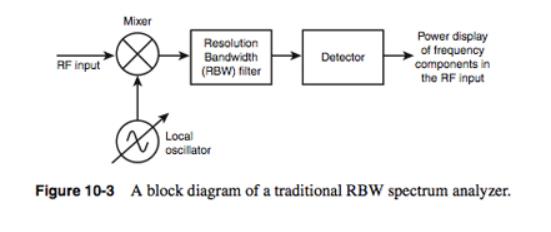
Figure 10-3
Figure 10-3 shows a test of the balance between frequency resolution and time. The local oscillator provides a "sweep" frequency to the mixer, and each sweep provides a different frequency and its corresponding value at the mixer output. The resolution filter is set in a user-selectable frequency range, which is the resolution bandwidth (RBW). The narrower the filter bandwidth, the higher the resolution of the measuring instrument and the better the elimination of instrument noise. The RBW filter is followed by a detector to measure the instantaneous frequency power of each frequency value. Because this method can provide a higher dynamic range, its main advantage is that it can calculate the amplitude value of a frequency point at a certain point in time. If the RBW filter is designed to be too narrow, it will take a long time to complete a sweep of the RF input, so that some changes in the input RF signal cannot be detected. Scanning in a frequency domain or several passbands will take a considerable amount of time. The premise of this test technique is to assume that the signal will not change significantly during the test period of multiple sweeps. Therefore, a relatively stable, A constant input signal is necessary. If the signal changes frequently, you may not get results.
For example, the left side of Figure 10-4 shows the result of an RBW logic analyzer test. The frequency is Fa at the beginning, but at a moment the frequency becomes Fb. When the scan reaches Fb, the signal has disappeared and cannot be detected. Therefore, the scan of the RBW spectrum analyzer cannot provide a trigger at Fb, so it cannot store the comprehensive signal conditions in a period of time. This is a classic example of the balance between frequency resolution and test time, and it is also the Achilles' heel of the RBW spectrum analyzer.
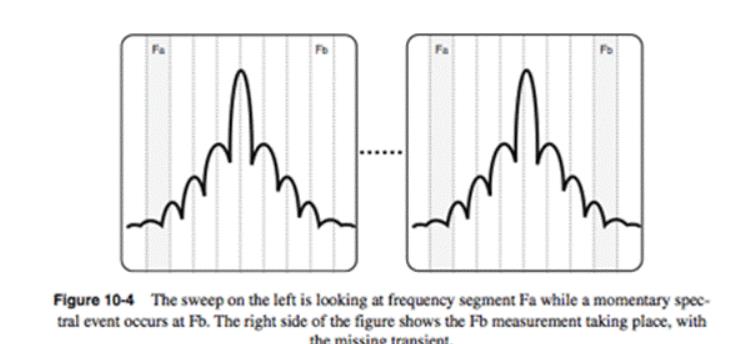
Figure 10-4
However, the latest scanning spectrum analyzer is much faster than the traditional analog processing-based equipment in the past. Figure 10-5 shows the architecture of a modern excellent scanning spectrum analyzer. Traditional analog RBW filters have been digitally enhanced to facilitate fast and accurate narrowband filtering. However, the filters, mixers, and amplifiers before the ADC all perform analog processing. In particular, the nonlinearity and noise in the ADC need to be considered. Therefore, there is still a place for analog spectrum analyzers, which can avoid the above-mentioned problems.
Figure 10-5
